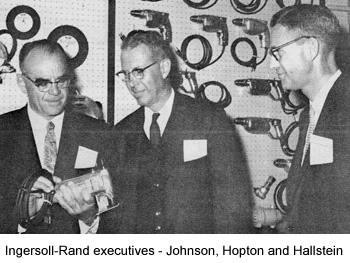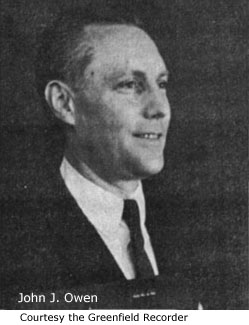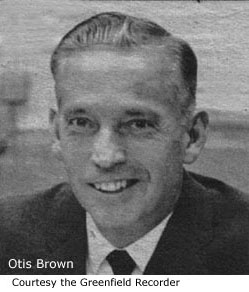Millers Falls Company: 1962-1969
The Ingersoll-Rand buyout
 By the early 1960s, the board of directors of the Millers Falls Company had become increasingly concerned about the future of the business. Company president Philip Rogers and chief financial officer Earl D. Holtby were ready to retire, and since the company’s shares were not actively traded, several elderly board members were concerned a takeover attempt might result in a series of sales at less than fair market price for the operation. Their fears were not entirely unjustified. Howard Butcher, a Philadelphia financier with a reputation for ruthlessness, was showing an interest in the company and controlled 10.2 percent of the shares, held in street name. The charge given to executive vice-president John J. Owen by the directors was straightforward: find a merger partner listed on the New York Stock Exchange so that shares in the new entity would be liquid, and ensure the deal would meet the approval of anti-trust regulators at Federal Trade Commission. (At the time, anti-trust regulations were stringent.)
By the early 1960s, the board of directors of the Millers Falls Company had become increasingly concerned about the future of the business. Company president Philip Rogers and chief financial officer Earl D. Holtby were ready to retire, and since the company’s shares were not actively traded, several elderly board members were concerned a takeover attempt might result in a series of sales at less than fair market price for the operation. Their fears were not entirely unjustified. Howard Butcher, a Philadelphia financier with a reputation for ruthlessness, was showing an interest in the company and controlled 10.2 percent of the shares, held in street name. The charge given to executive vice-president John J. Owen by the directors was straightforward: find a merger partner listed on the New York Stock Exchange so that shares in the new entity would be liquid, and ensure the deal would meet the approval of anti-trust regulators at Federal Trade Commission. (At the time, anti-trust regulations were stringent.)
In early 1962, as Owen was developing his list of merger prospects, a representative of the Ingersoll-Rand Company phoned Greenfield to express an interest in acquiring the Millers Falls Company. Ingersoll-Rand, a manufacturer of industrial tools and machinery, was looking for an easy entry into the consumer hand tool business and was on the rebound after failing in an attempt to acquire the Black & Decker Company. The Black & Decker deal, nearly complete, had been scotched when Robert Black, a brother to B & D founder S. Duncan Black, “spilled the beans to the press” after the per-share swap arrangement had been negotiated. Although a second choice, Ingersoll-Rand saw the Millers Falls Company as a viable alternative; its electric tools had a reputation for quality and world-wide name recognition.(1)
The primary negotiators for Ingersoll-Rand were: Lester C. Hopton, president; Robert H. Johnson, chairman of the board; and D. Wayne Hallstein, executive vice president. John Owen and the firm’s legal counsel, David Pokrass of Peabody, Brown, Rowley & Storey, a Boston law firm, represented Millers Falls. The resulting agreement specified an exchange ratio of one share of Ingersoll-Rand common stock for every 3.4 shares of Millers Falls stock outstanding. The deal was announced on May 17, 1962, and on that day, the 250,599 outstanding shares of Millers Falls Company stock were valued at $4,883,000.(2) The shareholders of the Millers Falls Company approved the agreement on June 15th by a margin of over ninety percent. Major shareholders voting for the arrangement included the Rogers family, owners of about 15 percent of the shares outstanding, and Howard Butcher, the Philadelphia financier.
John Owen, company president
 The Ingersoll-Rand Company retired the Millers Falls senior management and chose John J. Owen—“Jack” to his friends and associates—as company president. Owen, the grandson of George Rogers, was the logical person for the job. At one time or another, he had held positions as assistant plant superintendent, advertising manager, assistant to the executive vice president, and executive vice president. His degree in mechanical engineering and experience as assistant plant superintendent provided a solid background in production; his experience as advertising manager ensured he had an understanding of the sales side of the operation. Owen would later recall, “Of course, it didn’t hurt that I knew the names of 500 non-union workers.”
The Ingersoll-Rand Company retired the Millers Falls senior management and chose John J. Owen—“Jack” to his friends and associates—as company president. Owen, the grandson of George Rogers, was the logical person for the job. At one time or another, he had held positions as assistant plant superintendent, advertising manager, assistant to the executive vice president, and executive vice president. His degree in mechanical engineering and experience as assistant plant superintendent provided a solid background in production; his experience as advertising manager ensured he had an understanding of the sales side of the operation. Owen would later recall, “Of course, it didn’t hurt that I knew the names of 500 non-union workers.”
The company Owen headed was not the aggressive, growing concern it had been earlier in the century. At the time of the buyout, Millers Falls employed some 600 workers—substantially fewer than the 1300 employed in the early 1950s—and its elderly, increasingly risk-averse board of directors had skimped on investment in plant and equipment. Ingersoll-Rand’s charge to Jack Owen was simple, if presumptuous: “We want you to be as big as Black and Decker in five years.” The feasibility of his task aside, the path, to Owen, was clear. Millers Falls needed to move away from the consumer hand tool business. Consumer hand tools were deeply discounted and profit-per-unit was relatively low. It was a high-volume business not well-suited to a small manufacturer—especially one with high distribution costs because it had alienated the consumer tool wholesalers. Owen believed the Millers Falls Company had the expertise to build hand tools for the industrial and professional market, that it had the reputation to sell them, and most importantly, that those tools, selling at much smaller discounts, would be more profitable on a per-unit basis.
As part of the Ingersoll-Rand family of companies, Millers Falls had access to resources unavailable to it as an independent operation. One of these was the ability to piggyback onto existing Ingersoll-Rand sales efforts. Even then, the company’s absence from the wholesale distribution network made its consumer hand tools vulnerable to subterfuge by competitors. James N. Mitchell, vice-President and distribution manager of P & C Tool Company, and later a president of Millers Falls, would recall:
When IR bought M.F. Co., I was working for a subsidiary of [Pendleton] Tool Co., also owned by IR. We sold wrenches, sockets, plumbing tools, screwdrivers, etc., to hardware stores through wholesale hardware distributors. This was the P & C brand. When M.F. was acquired, we added their line of hand woodworking tools, branded P & C. This created a war with Stanley because M.F. was almost out of this market as a result of going direct to the hardware retailer. Stanley told their wholesalers that they would lose the Stanley line if they handled the P & C line of woodworking tools. While illegal, they forced us out of the market within a year.(3)
Jack Owen was able to take advantage of Ingersoll-Rand’s considerable expertise in office and data management. Unbelievably, at the time of the buyout, the company was still paying its employees in cash. Every Friday, office manager Earl Brown and two woman payroll clerks would go to the local bank to make up the firm’s payroll envelopes—one for each employee—carefully counting and double-checking currency and coins before inserting them into the jackets. With the assistance of the new parent company, a data processing department was created, a new IBM computer was installed, and thereafter, workers were paid by check. The transition resulted in one memorable protest. An older employee, on receiving his first check, went to the payroll office with the complaint, “My check isn’t as much as my cash used to be.” An investigation revealed the worker’s foreman had been adding cash from his own pocket to the man’s payroll envelope each week. The worker, no longer as productive as he once had been, was accomplishing less than his peers. Since most of the firm’s production workers were paid by the number of jobs completed—a system referred to as piece work—the worker was earning less than others in his department. Not wanting a friend to feel that he couldn’t hold up his end of the work, the foreman was making up the difference.
Differences in corporate culture soon resulted in strained relationships between Ingersoll-Rand and Millers Falls management. Ingersoll-Rand was bottom-line driven; Millers Falls had traditionally put working relationships first, product second, and profit third. Things came to a head in 1965 when Ingersoll-Rand assumed responsibility for marketing Millers Falls products in Europe. Jack Owen traveled to Europe to close out the old sales operation—an entity known as Millers Falls Werkzeug Gmbh. The principal distributor for Millers Falls Werkzeug was Hans Christen, and Millers Falls had made a good faith arrangement to hold him harmless for the first $25,000 of his expenses should the arrangement be terminated. On his return to the United States, Owen visited Ingersoll-Rand headquarters and reported to executive vice-president D. Wayne Hallstein the task had been completed save for the writing of Christen’s settlement check. Hallstein listened and then advised Owen the check was unnecessary as the legal entity that made the agreement—Millers Falls Werkzeug Gmbh—was no longer in existence. When Owen insisted on honoring the agreement, Hallstein responded with a statement that Owen would remember with clarity some forty years later: “Jack, to succeed in our business, you have to have a little larceny in your heart.” The meeting ended in an argument with Owen on the verge of resigning, Hallstein on the verge of firing him, and the issue unresolved. Feeling ethically bound by the hold-harmless agreement with Christen, Owen returned to Greenfield and instructed treasurer Lucius Nims to write the settlement check. As Christen was planning to attend an upcoming hardware show in the United States, arrangements were made to present the check to him at the meeting. Nims and Christen, unaware of the sensitive nature of the transaction, had a photo taken of the event. It was subsequently published in an issue of Dyno-mite, the company employee magazine, where it was seen by a decidedly unhappy D. Wayne Hallstein.
 On February 15th, 1966, just two months after Owen’s unhappy meeting with D. Wayne Hallstein, Millers Falls workers elected to unionize by a margin of 12 votes. The result of the election came as a blow to Jack Owen for it meant a United Electrical Workers representative would take his place in representing workers’ concerns to Ingersoll-Rand. Coupled with his very real sense of loss was an understanding that, without his role as mediator, he had become less valuable to Ingersoll-Rand. Six days after the union vote, John J. Owen turned fifty years old. The birthday qualified him for the Ingersoll-Rand retirement plan. (His years at Millers Falls before and after the merger were enough to vest him.) Owen retired and embarked on a successful second career as an educational fund-raiser. His first position was that of director of the capital campaign at Deerfield Academy. In 1968, he was offered the post of director of corporate relations at Yale University. After eight years at Yale, Owen moved on to the University of Virginia, in Charlottesville, where he served for ten years as vice president for development.
On February 15th, 1966, just two months after Owen’s unhappy meeting with D. Wayne Hallstein, Millers Falls workers elected to unionize by a margin of 12 votes. The result of the election came as a blow to Jack Owen for it meant a United Electrical Workers representative would take his place in representing workers’ concerns to Ingersoll-Rand. Coupled with his very real sense of loss was an understanding that, without his role as mediator, he had become less valuable to Ingersoll-Rand. Six days after the union vote, John J. Owen turned fifty years old. The birthday qualified him for the Ingersoll-Rand retirement plan. (His years at Millers Falls before and after the merger were enough to vest him.) Owen retired and embarked on a successful second career as an educational fund-raiser. His first position was that of director of the capital campaign at Deerfield Academy. In 1968, he was offered the post of director of corporate relations at Yale University. After eight years at Yale, Owen moved on to the University of Virginia, in Charlottesville, where he served for ten years as vice president for development.
Otis E. Brown
John Owen was still company president when Otis Brown moved to Greenfield in December of 1965. Formerly vice-president of personnel for Ingersoll-Rand’s Pendleton Tool Industries division, Brown was assigned to the Millers Falls Company with the title of chief executive officer. At the time of Brown’s arrival, Owen was offered the title of chairman of the board but turned it down believing the president’s title put him in a stronger position to mediate differences between the company and workers prior to the upcoming unionization vote. Otis Brown was a protégé of Morris Pendleton, the long-term president of Pendleton Tool Industries both before, and after, its merger with Ingersoll-Rand. (Pendleton manufactured the well-known Proto line of tools.) A large stockholder in the Ingersoll-Rand Company by virtue of the sale of Pendleton Tool to the parent operation, Morris Pendleton was given a great deal of latitude in his work within the Ingersoll organization. Hoping to fold the Millers Falls operation into his own subdivision, he requested a special assignment as consultant to the management in Greenfield. He made a number of trips to Greenfield during Jack Owen’s presidency and when otherwise occupied, sent Otis Brown in his place.
Brown added the title of company president to that of CEO when Jack Owen retired. The company he inherited had grown during Owen’s years as president. Sales had increased from twenty-five to thirty-five million dollars per year, a modest program of updating equipment had begun, and the number of employees had increased from 600 to 1,000. Although the new line of “shock-proof” electric tools was selling well, the operation’s problems were profound. Despite his predecessor’s attempts to improve plant and equipment, the factories remained victims of an ongoing lack of capital investment and too often deferred maintenance. The Ervingside plant in Millers Falls had deteriorated to the point that forklifts had broken through the flooring, and the condition of the Wells Street plant in Greenfield was not much better. The equipment at the factories was antiquated, and at least one machine had become the object of a museum inquiry.(4)
The long-standing problems were not entirely of Ingersoll-Rand’s making, but the difficulties were exacerbated when the firm did little to improve the situation. Although Morris Pendleton—with forty-seven years’ experience in the tool business—spent a good deal of time with Otis Brown trying to iron out the problems, Ingersoll-Rand’s inability to make a profit left little incentive for further investment in the company. Frustrated and concerned about his health, Otis Brown retired in 1969 and moved to Arizona. Despite the efforts of Morris Pendleton, the Millers Falls Company remained independent of his Pendleton Tool Industries subdivision. Ingersoll-Rand would make periodic efforts to sell the Millers Falls Company but failed to find a suitable buyer.(5)
Illustration credit
Ingersoll Rand executives with tools: Dyno-Mite, Oct. 1962.
References
- Unless otherwise specified, information on the buyout and Owen’s presidency: Telephone interviews, John J. Owen, January 5, 2005, and March 5, 2005.
- “Ingersoll-Rand Sets Acquisition”. New York Times. May 18, 1962. p. 45.
- E-mails to author, October 20, 2004, December 16, 2004, James N. Mitchell, company president, 1972-1980. In the this quote, I substituted the word “Pendleton” for Mitchell’s word “Proto.” Ingersoll-Rand employees frequently referred to Pendleton Tool by the name of its best known brand—Proto Tools. The P & C Hand Forged Tool Company of Milwaukie, Oregon, was acquired by Pendleton Tool in early 1941. (Pendleton Tool was named Plomb Tool Company at the time.) P & C took its name from its founders, John Peterson and Charles Carlborg, who had organized the business in 1920.
- On the forklift problems and museum inquiry: Greenfield Popular Union. More of the Same: Millers Falls Tool Threatens to Runaway. Turners Falls, Mass.: Greenfield Popular Union, 1977.
- On Pendleton’s assistance to Otis Brown: E-mail to author from James N. Mitchell, October 20, 2004.